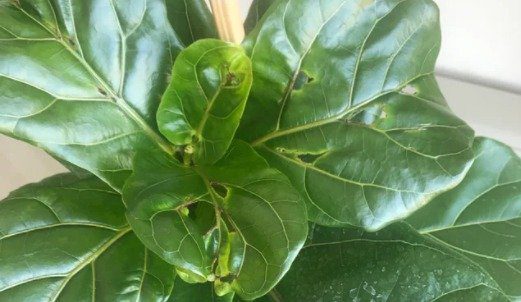The large, waxy leaves make these tropical trees a favorite plant choice for many homeowners because the sizable greenery brings an exotic look to indoor spaces.
However, within this popularity exists a problem:
Many homeowners often find holes in their fiddle leaf fig leaves. These holes suddenly appear and can decrease the beauty of this plant. Let’s find out who the culprit is…
Why Are There Holes in Fiddle Leaf Fig Leaves?
The main reason for holes in fiddle leaf figs is due to an insect infestation.
There are two common insects that damage these plants. They are the fiddle leaf fig tree mealybug and the black vine weevil, which are small, sap-sucking insects that feed on the stems of fiddle leaf fig trees.
There is also a chance of leaf fungus, which can occur if the leaves are exposed to excess moisture and poor air movement.
How to Treat Fiddle Leaf Fig with Holes?
There are several steps one can take to treat the holes, but neem oil is great for the majority of cases.
Start by pruning the affected leaves and getting rid of them from the plant as soon as possible. Also, make sure to remove any fallen debris from the floor below because it can serve as a breeding ground for insects.
An important note: DO NOT throw these leaves away in your compost pile just yet! The remaining eggs will hatch into more bugs that may infest your porch or backyard garden area if not properly treated.
Then, apply a neem oil spray (amazon link) to all surfaces of this plant including the leaves and stem. Neem oil is derived from seeds of the neem tree which have been used medicinally by Ayurvedic healers for centuries.
In the case of leaf fungus, you should increase humidity and make sure there is adequate light. In addition to increasing humidity, clean up any fallen leaves from the floor with a vacuum cleaner.
Again, neem oil works wonders here. It is a natural fungicide that will aid in the prevention of leaf fungus.
Care Guide for a Happy Fig
To prevent holes and any other problems in the future, it’s important to give your plant everything it needs to thrive.
Light – Fiddle leaf figs need plenty of natural light, so place the plant in an area where it will receive 6 hours or more of direct sunlight.
Water – Make sure you water this plant regularly (but not too much!) and fertilize every two weeks with a liquid fertilizer diluted to half-strength. Proper drainage is also important because stagnant water will cause root rot.
Temperature – Provide temperature ranges between 65-75 degrees Fahrenheit and humidity levels of over 50 percent. If you can’t meet all of these environmental conditions, you may want to invest in a humidifier or grow light.
Soil – Pot your fiddle leaf fig in a soil mixture that is high in organic material and drains well. You may also want to add a slow-release fertilizer in the pot when you purchase your plant.
Conclusion
In conclusion, yes, you should be concerned if you find holes in your fiddle leaf fig leaves.
However, don’t worry too much – if you take the proper steps to clean it up and treat the problem with neem oil, your plants will flourish like normal within a couple of weeks.
The good thing about neem oil is that it is an all-natural solution that can be used within organic gardening. Thanks for reading! If you enjoyed this article or learned something new, please don’t forget to share it with others so they have a chance to enjoy this free information.
Tim is an avid gardener from the UK. He was the founder of PlantCarer.com from 2021 to Sep 2023. He sold PlantCarer.com to Aaron. He has since started his own business called Seed To Supper, which provides new gardeners all the materials you need in a box (pots, seeds, compost and instructions) to grow your own delicious and nutritious vegetables and herbs from start to finish – no garden required.

